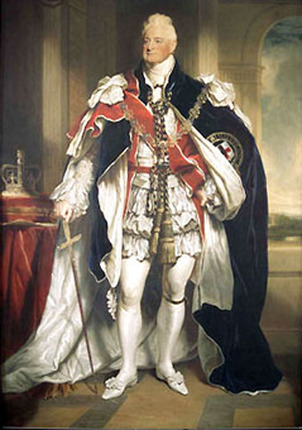Who Followed the Georgians?
My historical romance series about the Georgian era takes us from the wild passion of the Jacobite rebellion through to the charm and formality of the Regency. This was a period in history that gave us heroes and heroines we fall instantly in love with, fascinating and amusing supporting characters and luscious historical settings. But who came after the Georgians, how do we ‘bookmark’ their place in history?

William IV
William, Duke of Clarence, was the third son of George III. He served in the Royal Navy and saw action in America and the West Indies.
He lived openly with the actress, Dorothy Jordan, with whom he had ten children. In 1818, following the death of George IV’s daughter, Charlotte, there was a scramble amongst the royal princes to provide an heir. William married Adelaide of Saxe-Coburg. They had two daughters both of whom died in infancy.
Like his father and his older brother, King William was inclined to behave in an eccentric way. At the start of his reign he was a popular king but he lost some of this support when he began to oppose the parliamentary reforms he had previously upheld. He died in 1837.

Queen Victoria
Alexandrina Victoria was the only child of Edward, Duke of Kent, fourth son of George III, and Victoria of Saxe-Coburg. She was born in 1819 and was named after her godfather, Tsar Alexander II of Russia.
Victoria’s father died when she was eight months old and her mother developed a close relationship with Sir John Conroy who was an important figure in their lives.
When William IV died, Victoria aged 18. became queen. Victoria became very dependent on her Prime Minister, Lord Melbourne. Such was their closeness that Victoria was nicknamed ‘Mrs Melbourne’ by her subjects. In 1839, Melbourne was forced to resign and Sir Robert Peel became Prime Minister. Victoria refused to accept Peel’s request to replace the Whig ladies who served her with Tories and Peel resigned. Melbourne returned to office but Victoria’s popularity was dented. It was damaged further by her unsympathetic behaviour towards Lady Flora Hastings, one of her ladies in waiting, who died of cancer of the liver. There were seven assassination attempts on Victoria during her reign.
Victoria married her cousin, Prince Albert of Saxe-Coburg and they had nine children. Prince Albert was a reformer who was interested in the plight of the poor and he had a great influence over his wife’s political views. He died of typhoid in 1861 and, although Victoria continued to carry out her duties, she withdrew from public life and spent as much time as possible at her Scottish home, Balmoral. Here she became very close to one of her servants, John Brown.
During Victoria’s reign, Britain’s imperialism was at its height. Queen Victoria died in 1901.
My Pinterest Board about Queen Victoria is here:
http://www.pinterest.com/JaneGodman/queen-victoria/
